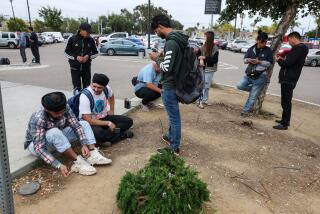Stalking Victims Added to Safety Net
- Share via
SACRAMENTO — A state program that shields the whereabouts of battered California women and their children from pursuing abusers is about to be expanded to include victims of stalkers.
“Stalkers are very adept at getting in between the lines, finding ways around things. You never know how safe you are or are not,” said a woman using the pseudonym Sarah, who is enrolled in the confidential address protection program as a victim of domestic violence.
Secretary of State Bill Jones has not estimated how many stalking victims will be added to the 17-
month-old Safe at Home program starting Jan. 1. Minimal documentation will be required for eligibility.
“We know there are a lot of them out there, but how many will take advantage of the program, we don’t know,” said program manager Shirley E. Washington.
Safe at Home allows victims who have ended violent domestic relationships and begun building new lives to be issued identification cards that list a post office box and a fictitious Sacramento address. Their real addresses are kept confidential.
The post office box is actually a free mail drop operated by Jones. Twice a day under tight security, staffers collect mail and forward it to the victims’ confidential addresses.
Participants’ public records, including voter registration documents and marriage license applications, are kept confidential for as long as the victim is in the program.
Based on a successful Washington state enterprise, Safe at Home in California has enrolled 301 people since its start in July 1999, Washington said.
Los Angeles County leads enrollees with 47, followed by Sacramento and Riverside counties, she said.
The program is intended to provide an additional net of safety for people fleeing domestic violence and seeking to reestablish themselves. Typically, that means hastily relocating, enrolling children in new schools, severing ties with family and friends, starting new bank accounts, applying for garbage collection and utility service, and registering cars. Each task can leave a paper trail.
Determined abusers, even those in prison, have shown themselves to be highly skilled at tracking down their former partners, domestic abuse victims and experts say.
It came as a surprise shortly after the California program was launched that Safe at Home was in
advertently rejecting some people who most needed help: stalking and some domestic violence victims.
A survey of local agencies that enroll participants in the state program reported that nearly 100 women who had applied were not approved, Washington said.
Though well-intentioned, the rules were, Jones said, “too restrictive” and resulted in “terrified victims being turned away from a program that was designed to help them.”
So, Jones and state Sen. Dede Alpert (D-Coronado), who introduced the 1998 legislation that led to the program, launched a bill, AB 1318, last session to fix the problem.
Signed by Gov. Gray Davis, the law will loosen certain eligibility standards for victims of domestic violence and create admission rules specifically for victims of stalkers.
“This is a great breakthrough,” said Jennifer Chen Speckman, who, as hotline program coordinator at Sojourn women’s center in Santa Monica, could only watch as deserving but technically ineligible women were turned down.
She said some applicants clearly had suffered “emotional abuse,” but lacked the documentation required to qualify, including a police report or court restraining order.
“It was a loophole,” she said.
The state program defines stalking as following or harassing a person and making a “credible threat” that causes the target to fear for the safety of herself, himself or immediate family members.
Domestic violence and stalking victims will be asked for evidence, such as police reports, court or government agency records to substantiate their claims. A sworn statement from “any other individual” with knowledge of a stalking claim will be accepted.
Scott Gordon, a deputy district attorney, welcomed the inclusion of stalking victims.
“We’re thrilled. There is a whole toolbox of services that can be offered. This is one more tool,” said Gordon, director of the Los Angeles County Domestic Violence Council.
“In 1994, our office filed about 85 felony stalking cases. Now, we’re up to 350 a year,” Gordon said.
Sarah, the woman who joined the Safe at Home program after leaving an abusive relationship, said stalking victims will find the security and safety they are seeking.
“It has made a difference in fearing for my life every day and now being able to relax a little bit and not look back over my shoulder,” she said.
More information is available on the Internet at https://www.ss.ca.gov/safeathome.
More to Read
Sign up for Essential California
The most important California stories and recommendations in your inbox every morning.
You may occasionally receive promotional content from the Los Angeles Times.










